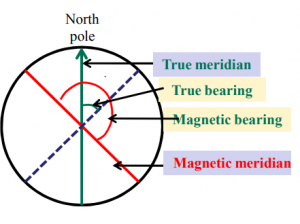Prismatic Compass Surveying PDF Notes Download
Compass surveying
Prismatic Compass

Compass traversing Important Definition
True meridian: A-Line or plane passing through geographical north pole and geographical south pole
Magnetic meridian: When the magnetic needle is suspended freely and balanced properly, unaffected by magnetic substances, it indicates a direction. This direction is known as magnetic meridian.
The angle between the magnetic meridian and a line is known as a magnetic bearing or simple bearing of the line.

Arbitrary meridian: Convenient direction is assumed as a meridian.
Grid meridian: Sometimes for preparing a map some state agencies assume several lines parallel to the true meridian for a particular zone these lines are termed as grid meridian.
Designation of a magnetic bearing
- Whole circle bearing (WCB)
- Quadrantal bearing (QB)
WCB: The magnetic bearing of a line measured clockwise from the North Pole towards the line is known as WCB. Varies 0-360°
Quadrantal Bearing: The magnetic bearing of a line measured clockwise or anticlockwise from NP or SP (whichever is nearer to the line) towards the east or west is known as QB.
This system consists of 4-quadrants NE, SE, NW, SW. The values lie between 0-90°
QB of OA = N a E
Reduced Bearing: When the whole circle bearing of a line is converted to quadrantal bearing it is termed as a reduced bearing.
Fore and Back Bearing:
In WCB the difference between FB and BB should be exactly
180°
- BB=FB+/-180°.
- Use the +ve sign when FB<180°
- Use the –ve sign when FB> 180°

Magnetic declination: The horizontal angle between the magnetic meridian and true meridian is known as magnetic declination.
Dip of the magnetic needle: If the needle is perfectly balanced before magnetisation, it does not remain in the balanced position after it is magnetised.
This is due to the magnetic influence of the earth. The needle is found to be inclined towards the pole. This inclination of the needle with the horizontal is known as dip of the magnetic needle.

Local Attraction
Method of correction for traverse:
First Method: Sum of the interior angle should be equal to (2n-4) x 90. if not than distribute the total error equally to all interior angles of the traverse. Then starting from unaffected line the bearings of all the lines are corrected using
corrected interior angles.
Second Method: Unaffected line is first detected. Then, commencing from the unaffected line, the bearing of other affected lines are corrected by finding the amount of correction at each station.
Download Pdf For compass Surveying Question With Solution
Prismatic Compass Surveying PDF Notes Download Click Below 
- Preliminary Survey
- What is Reconnaissance Survey
- What is Duties of Construction Surveyor
- Quality Control PDF Download
- History of Cement
- Different types of scaffolding
- Basic Knowledge about Bridge Engineering
- Properties of Cement
- Different varieties of cement
- Common Tests on Building Stones
- Types of Tiles
- Moulding of Bricks



Problems on anti clock wise moment traverse angles